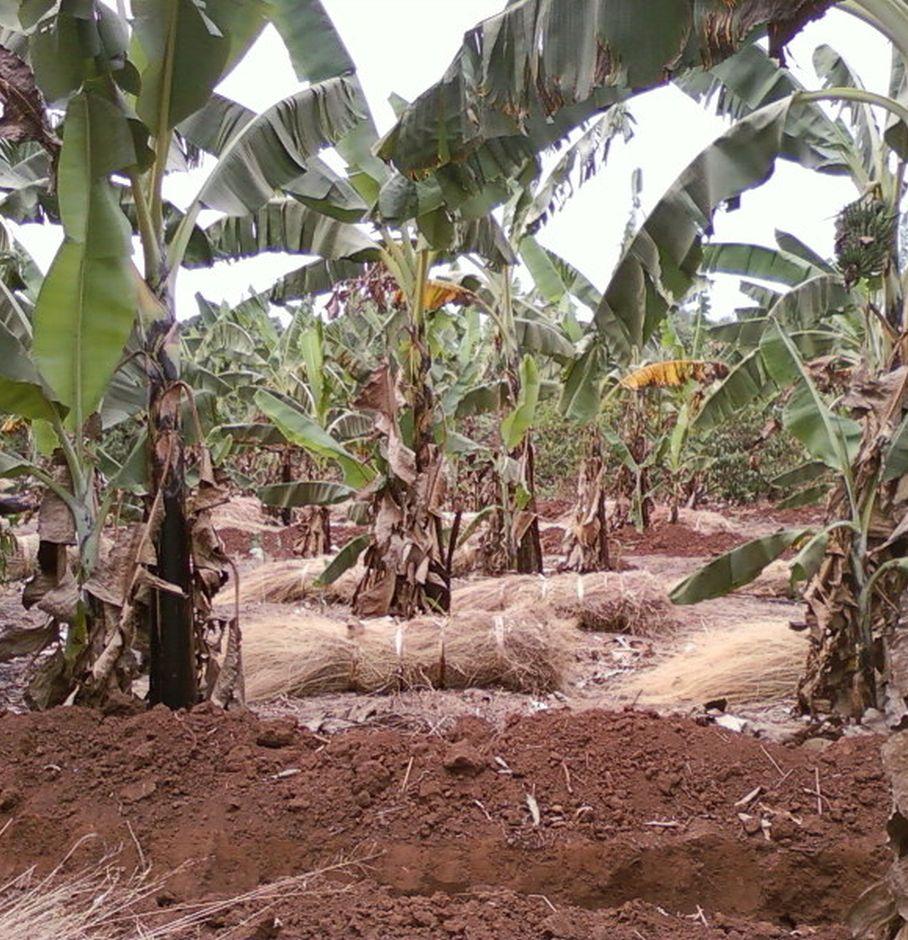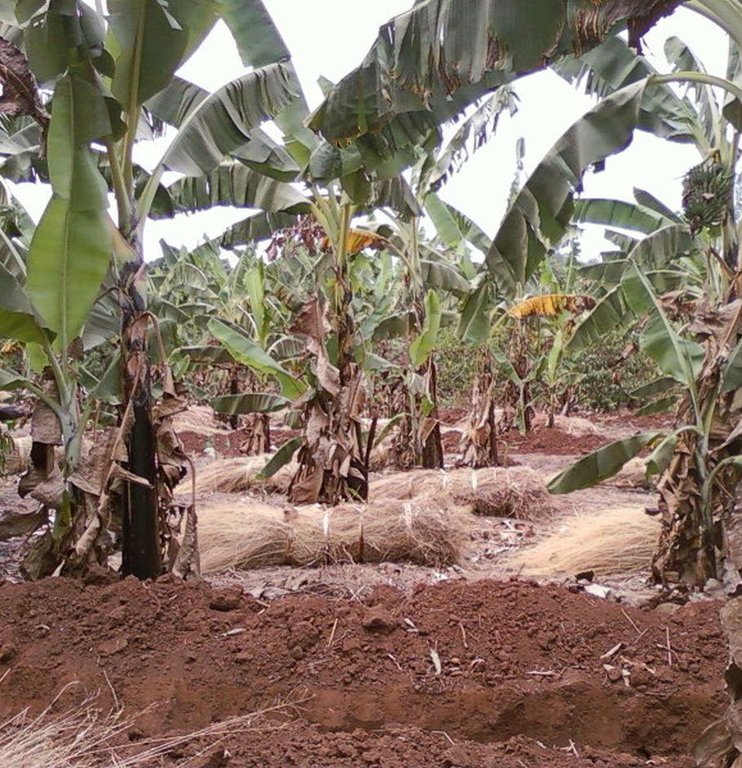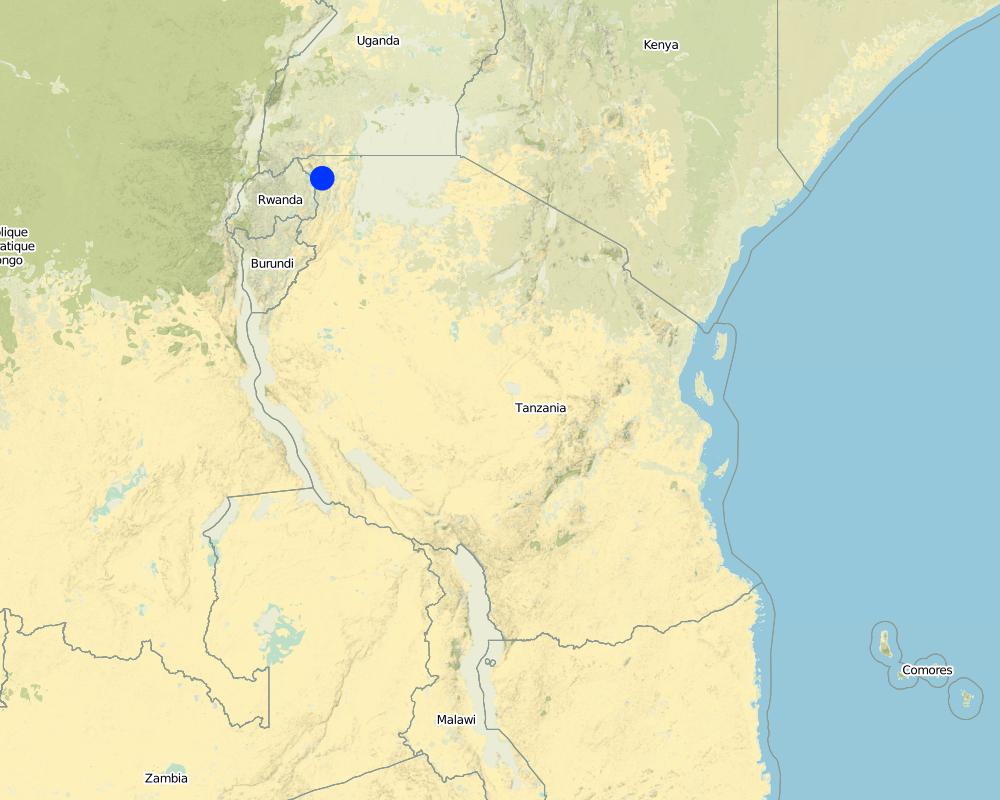Contour ditches combined with manures and mulch grass in banana production. [坦桑尼亚联合共和国]
- 创建:
- 更新:
- 编制者: Godfrey Baraba
- 编辑者: –
- 审查者: David Streiff, Alexandra Gavilano
makinga maji ya kati
technologies_1215 - 坦桑尼亚联合共和国
查看章节
全部展开 全部收起1. 一般信息
1.2 参与该技术评估和文件编制的资源人员和机构的联系方式
SLM专业人员:
有助于对技术进行记录/评估的项目名称(如相关)
The Transboundary Agro-ecosystem Management Project for the Kagera River Basin (GEF-FAO / Kagera TAMP )有助于对技术进行记录/评估的机构名称(如相关)
Missenyi District Council (Missenyi District Council) - 坦桑尼亚联合共和国有助于对技术进行记录/评估的机构名称(如相关)
Bukoba district council (Bukoba district council) - 坦桑尼亚联合共和国1.3 关于使用通过WOCAT记录的数据的条件
编制者和关键资源人员接受有关使用通过WOCAT记录数据的条件。:
是
1.4 所述技术的可持续性声明
这里所描述的技术在土地退化方面是否存在问题,导致无法被认为是一种可持续的土地管理技术?:
否
2. SLM技术的说明
2.1 技术简介
技术定义:
Is a cross slope berier characterised with 2m widith by 2m depth furrow, farm yard manures and grass mulch in banana production.
2.2 技术的详细说明
说明:
The level ditches combined with farm trushlines, farm yard manure, and grass mulch technology in banana production is the digging of a furrow measured 2m wide by 2m deep along the contour in the banana plantation. The technology is applied on a perennial cropland by combining structural, vegetative and agronomic measures. The climatic zone is sub humid in a gentle to moderate slope with medium to deep loam clay soils. The hand cultivation is done manual using hand hoes in a mixed production system. The establishment procedures contour demarcation using a local made A-frame, digging a furrow along the contour, digging the banana holes spaced at 3.6m by 3.6m between the structures, mixing farm yard manure with top soils and planting banana suckers after restng the mixture for not less than 60 days. The maintenance procedures requires, weeding the field, desuckering, detrushing, planting beans, topical manure application, grass mulch application and filling the contour furrow with farm trushlines. The land ownership is individual not titled. This technology was introduced in 2012 by Kagera TAMP using the FFS methodology. In case of sensitive climatic extremities
Purpose of the Technology: The major purpose for technology application is reduced moisture stress, increased soil water retention, reduced soil erosion to increase crop productivity in a sustainable land management.
Establishment / maintenance activities and inputs: The establishment activities included; first to clear the field and demarcate the contour line using a local made A-frame done at the end of short rains. Second is to plough and harrow the field done in the early dry season. Third is to space and dig holes for planting banana suckers done in mid of dry season. Fourth is mixing farm yard manures with top soils and cover the hole for not less than sity days before planting, this is done in mid of dry spell. Fourth is to plant certified banana suckers done in late dry season. Fifth is to dig the contour ditch done in at the onset of long rainfall. The maintenance activities includes; first to weed the entire field done twice before the onset of rainfalls. Second is to apply farm yard manures concurrently with grass mulch done once in the late dry period. Third is to desucker and detrush banana plants done twice before planting beans. Fourth is to plant beans done once before the onset of long rainfalls.
Natural / human environment: The natural environment in the location is 750-1000 mm rainfalls, foots lopes valley floors landform, gentle slope, shallow to meium soil depth (50-80)cm and (80-120)cm characterised with two growing periods. The social economic persisting are small scale land users farming on( 0.5 to 2)ha per house hold. The land ownership is individual not titled while the water use rights is open access. The importance of off-farm incomes is less than 10% and the market orientation is mixed while soil cultivation is manual and livestock are not fed on farm residues.
2.3 技术照片
2.5 已应用该技术的、本评估所涵盖的国家/地区/地点
国家:
坦桑尼亚联合共和国
区域/州/省:
Tanzania
有关地点的进一步说明:
Karagwe District Council
具体说明该技术的分布:
- 均匀地分布在一个区域
如果不知道精确的区域,请注明大致覆盖的区域:
- < 0.1 平方千米(10 公顷)
注释:
Three host farmers of FFS allocated a total of 1.5 acres (three different sites) as a leaning sites. While 22 group members implimented the technology with modifications in their farms with average of 0.5ha X22 =1.1ha
Map
×2.6 实施日期
如果不知道确切的年份,请说明大概的日期:
- 不到10年前(最近)
2.7 技术介绍
详细说明该技术是如何引入的:
- 通过项目/外部干预
注释(项目类型等):
Introduced by TAMP -Kagera, Tanzania in 2012 using FFS methodology.
3. SLM技术的分类
3.1 该技术的主要目的
- 减少、预防、恢复土地退化
3.2 应用该技术的当前土地利用类型

农田
- 一年一作
- 多年一作(非木材)
- 乔木与灌木的种植
年作 - 具体指明作物:
- 谷物类 - 玉米
- 豆科牧草和豆类 - 豆子
- 根/块茎作物 - 红薯、山药、芋头/椰子,其他
多年生(非木质)作物 - 指定作物:
- 香蕉/芭蕉/蕉麻
乔木和灌木种植 - 指定作物:
- 咖啡,露天种植
每年的生长季节数:
- 2
具体说明:
Longest growing period in days: 90; Longest growing period from month to month: October to December; Second longest growing period in days: 60; Second longest growing period from month to month: March to May
注释:
Major land use problems (compiler’s opinion): The major land use problem related to soil and vegetation in the area were soil erosion, soil moisture stress and fertility decline and reduced organic matter content.
Major land use problems (land users’ perception): moisture stresss and soil erosion.
3.4 供水
该技术所应用土地的供水:
- 雨养
3.5 该技术所属的SLM组
- 改良的地面/植被覆盖
- 土壤肥力综合管理
3.6 包含该技术的可持续土地管理措施

农艺措施
- A2:有机质/土壤肥力
- A3:土壤表面处理

植物措施
- V5:其它

结构措施
- S2:堤、岸
注释:
Specification of other vegetative measures: lemon grass
Type of agronomic measures: better crop cover, mulching, temporary trashlines, manure / compost / residues
Type of vegetative measures: aligned: -contour, scattered / dispersed
3.7 该技术强调的主要土地退化类型

土壤水蚀
- Wt:表土流失/地表侵蚀

化学性土壤退化
- Cn:肥力下降和有机质含量下降(非侵蚀所致)

生物性退化
- Bl:土壤寿命损失
注释:
Main causes of degradation: soil management (cultivating along the slopes), crop management (annual, perennial, tree/shrub) (continous banana production without soil fertilization.), change of seasonal rainfall (dry spell prolonged), droughts (the area experienced a six months dry period.), population pressure (High population growth rates had forced to cultivate slope lands to feed the population.), poverty / wealth (community cant afford to invest in soil conservation.), education, access to knowledge and support services (inadequate staffing reduces extension services rendered to farmes.), governance / institutional (Agriculture policy had a narrow focus on environmental issues.)
3.8 防止、减少或恢复土地退化
具体数量名该技术与土地退化有关的目标:
- 防止土地退化
- 减少土地退化
4. 技术规范、实施活动、投入和成本
4.1 该技术的技术图纸
技术规范(与技术图纸相关):
Technical knowledge required for field staff / advisors: low (Basic agronomy principles, farm structures and vegetation management are taught at colleges.)
Technical knowledge required for land users: low (most of material required to implement the technology are common to them.)
Main technical functions: control of raindrop splash, control of dispersed runoff: retain / trap, control of dispersed runoff: impede / retard, improvement of ground cover, stabilisation of soil (eg by tree roots against land slides), increase in organic matter, increase in nutrient availability (supply, recycling,…), increase of infiltration, increase / maintain water stored in soil, increase of biomass (quantity)
Better crop cover
Material/ species: Pumpukins and water melon
Remarks: spaced at 3m in the space between the contour bunds.
Mulching
Material/ species: hyperhamia spps
Quantity/ density: 1500
Remarks: spread across the slope with 15cm thick covering the soil surfaces where banana and coffee are plant
Temporary trashlines
Material/ species: banana dry leaves and psodstems.
Manure / compost / residues
Material/ species: farm yard manures
Quantity/ density: 48979
Remarks: 60kg per plant during planting and 36kg for maintenance.
Aligned: -contour
Vegetative material: G : grass
Number of plants per (ha): 1666
Spacing between rows / strips / blocks (m): 18
Vertical interval within rows / strips / blocks (m): 0.6
Width within rows / strips / blocks (m): 0.3
Scattered / dispersed
Vegetative material: O : other
Number of plants per (ha): 778
Structural measure: contour bund
Spacing between structures (m): 18
Depth of ditches/pits/dams (m): 0.6
Width of ditches/pits/dams (m): 0.6
Length of ditches/pits/dams (m): 100
Height of bunds/banks/others (m): 0.3
Width of bunds/banks/others (m): 0.6
Length of bunds/banks/others (m): 100
Construction material (earth): soils excavated from the furrow.
4.2 有关投入和成本计算的一般信息
具体说明成本计算所用货币:
- 美元
注明雇用劳工的每日平均工资成本:
2.64
4.3 技术建立活动
| 活动 | 时间(季度) | |
|---|---|---|
| 1. | To plant lemon grass | March |
| 2. | To plant water melon | april |
| 3. | To gape fill lemon grasse | september |
| 4. | Dermacating the contour lines using simple made tool (A-frame) | June |
| 5. | To dig a furrow and excavating the soils to be placed on either lower side or upper side of the furrow. | August |
4.4 技术建立所需要的费用和投入
| 对投入进行具体说明 | 单位 | 数量 | 单位成本 | 每项投入的总成本 | 土地使用者承担的成本% | |
|---|---|---|---|---|---|---|
| 劳动力 | Labour | ha | 1.0 | 609.45 | 609.45 | |
| 设备 | Tools | ha | 1.0 | 114.71 | 114.71 | |
| 植物材料 | Seedlings | ha | 1.0 | 420.17 | 420.17 | |
| 肥料和杀菌剂 | Compost / manure | ha | 1.0 | 756.3 | 756.3 | |
| 技术建立所需总成本 | 1900.63 | |||||
| 技术建立总成本,美元 | 1900.63 | |||||
注释:
Duration of establishment phase: 12 month(s)
4.5 维护/经常性活动
| 活动 | 时间/频率 | |
|---|---|---|
| 1. | Weeding in the space where coffee and banana are planted. | january and June |
| 2. | desuckering | February and August |
| 3. | Detrushing | February and August |
| 4. | manure application | July |
| 5. | Spreading mulch grasses | September |
| 6. | Harvesting banana and coffee. | routeenly |
| 7. | To harvest lemon grass | routeenly |
| 8. | To remove soil sedments from the furrow and place them along the contour lines. | june and January. |
4.6 维护/经常性活动所需要的费用和投入(每年)
| 对投入进行具体说明 | 单位 | 数量 | 单位成本 | 每项投入的总成本 | 土地使用者承担的成本% | |
|---|---|---|---|---|---|---|
| 劳动力 | Labour | ha | 1.0 | 416.91 | 416.91 | 100.0 |
| 植物材料 | Seeds | ha | 1.0 | 88.24 | 88.24 | 100.0 |
| 肥料和杀菌剂 | Compost / manure | ha | 1.0 | 252.1 | 252.1 | 100.0 |
| 肥料和杀菌剂 | Grass mulch | ha | 1.0 | 441.18 | 441.18 | 100.0 |
| 技术维护所需总成本 | 1198.43 | |||||
| 技术维护总成本,美元 | 1198.43 | |||||
注释:
Labour calculated per ha of land protected, Farm yard manure calculated per plants applied, mulch grass calculated per ha of land protected, seedling and seeds calculated per ha of land protected.
4.7 影响成本的最重要因素
描述影响成本的最决定性因素:
The most determinate factor affecting the cost is labour
5. 自然和人文环境
5.1 气候
年降雨量
- < 250毫米
- 251-500毫米
- 501-750毫米
- 751-1,000毫米
- 1,001-1,500毫米
- 1,501-2,000毫米
- 2,001-3,000毫米
- 3,001-4,000毫米
- > 4,000毫米
农业气候带
- 半湿润
Thermal climate class: tropics
5.2 地形
平均坡度:
- 水平(0-2%)
- 缓降(3-5%)
- 平缓(6-10%)
- 滚坡(11-15%)
- 崎岖(16-30%)
- 陡峭(31-60%)
- 非常陡峭(>60%)
地形:
- 高原/平原
- 山脊
- 山坡
- 山地斜坡
- 麓坡
- 谷底
垂直分布带:
- 0-100 m a.s.l.
- 101-500 m a.s.l.
- 501-1,000 m a.s.l.
- 1,001-1,500 m a.s.l.
- 1,501-2,000 m a.s.l.
- 2,001-2,500 m a.s.l.
- 2,501-3,000 m a.s.l.
- 3,001-4,000 m a.s.l.
- > 4,000 m a.s.l.
5.3 土壤
平均土层深度:
- 非常浅(0-20厘米)
- 浅(21-50厘米)
- 中等深度(51-80厘米)
- 深(81-120厘米)
- 非常深(> 120厘米)
土壤质地(表土):
- 中粒(壤土、粉土)
表土有机质:
- 中(1-3%)
如有可能,附上完整的土壤描述或具体说明可用的信息,例如土壤类型、土壤酸碱度、阳离子交换能力、氮、盐度等。:
Soil fertility is medium
Soil drainage / infiltration is medium
Soil water storage capacity is medium
5.4 水资源可用性和质量
地表水的可用性:
过量
水质(未处理):
良好饮用水
关于水质和水量的注释和进一步规范:
Availability of surface water: Excess during short rainfals and medium because two permanent river tributaries (misheke and Charuhanga) flows throughout the year.
Water quality (untreated): Good drinking water when gravity water supply from Kasunkuni river tributar and poor when over-flooded Mwisa river during short rains.
5.5 生物多样性
物种多样性:
- 中等
关于生物多样性的注释和进一步规范:
Mchwa, sisimizi, vipepeo and earth worms
5.6 应用该技术的土地使用者的特征
生产系统的市场定位:
- 混合(生计/商业)
非农收入:
- 低于全部收入的10%
相对财富水平:
- 贫瘠
- 平均水平
个人或集体:
- 个人/家庭
机械化水平:
- 手工作业
性别:
- 女人
- 男人
说明土地使用者的其他有关特征:
Land users applying the Technology are mainly common / average land users
Population density: 50-100 persons/km2
Annual population growth: < 0.5%
99% of the land users are average wealthy and own 100% of the land.
1% of the land users are poor.
Off-farm income specification: Land users who applied the technolgy can meet hie/her cost of living (mainly food) from farm income while land users who have not applied the technology can not the household cost of living from the farm.
Market orientation of production system: Coffee are for sale while banana only excess is for sale.
Level of mechanization: Hand hoes use during farm establishment, but late local made tool (vihosho) are used for weeding and desuckering purpoes.
5.7 应用该技术的土地使用者使用的平均土地面积
- < 0.5 公顷
- 0.5-1 公顷
- 1-2 公顷
- 2-5公顷
- 5-15公顷
- 15-50公顷
- 50-100公顷
- 100-500公顷
- 500-1,000公顷
- 1,000-10,000公顷
- > 10,000公顷
这被认为是小规模、中规模还是大规模的(参照当地实际情况)?:
- 小规模的
注释:
< 0.5 and 0.5-1 ha: 75 % of landusers
2-5 ha: 25 percent of landusers
5.8 土地所有权、土地使用权和水使用权
土地所有权:
- 个人,未命名
土地使用权:
- 社区(有组织)
- 个人
用水权:
- 自由进入(无组织)
5.9 进入服务和基础设施的通道
健康:
- 贫瘠
- 适度的
- 好
教育:
- 贫瘠
- 适度的
- 好
技术援助:
- 贫瘠
- 适度的
- 好
就业(例如非农):
- 贫瘠
- 适度的
- 好
市场:
- 贫瘠
- 适度的
- 好
能源:
- 贫瘠
- 适度的
- 好
道路和交通:
- 贫瘠
- 适度的
- 好
饮用水和卫生设施:
- 贫瘠
- 适度的
- 好
金融服务:
- 贫瘠
- 适度的
- 好
6. 影响和结论性说明
6.1 该技术的现场影响
社会经济效应
生产
作物生产
注释/具体说明:
Not yet harvested the first yield
生产故障风险
注释/具体说明:
Mulch grass have reduced moisture stresses
收入和成本
农业投入费用
注释/具体说明:
Farm yard manures, mulch grasses, lemon seedlings, certified banana suckers and water melon seed
收入来源的多样性
注释/具体说明:
Lemon grasses and pumpukins sales
工作量
注释/具体说明:
Additional activies should demamnd more labours
社会文化影响
食品安全/自给自足
注释/具体说明:
Increased food production should ensure availability, while sale of coffee should ensure accebility to balance the diet
社区机构
注释/具体说明:
FFS group members
国家机构
注释/具体说明:
Out-soucing of activities to TCRA
SLM/土地退化知识
注释/具体说明:
Udelt learning using FFS methodology
社会经济弱势群体的情况
注释/具体说明:
Three group members have no land, male and female have equal chances in the group
生态影响
水循环/径流
地表径流
注释/具体说明:
Mulch grasses and contour bung
蒸发
注释/具体说明:
Mulch grasses
土壤
土壤水分
注释/具体说明:
Mulch grasses
土壤覆盖层
注释/具体说明:
Mulch grass and pumpukins
土壤流失
注释/具体说明:
Lemon grasse planted along the contour bunds
土壤有机物/地下C
注释/具体说明:
Farm yard manures application
生物多样性:植被、动物
生物量/地上C
注释/具体说明:
Mulch grass and trushlines
害虫/疾病控制
注释/具体说明:
Use of certicefid banana suckers
减少气候和灾害风险
火灾风险
注释/具体说明:
Attention for grasses collection before fire seting on has increased
6.2 该技术的场外影响已经显现
对邻近农田的破坏
注释/具体说明:
Water run-off reduction
对公共/私人基础设施的破坏
注释/具体说明:
No longer concentrated run-off
6.3 技术对渐变气候以及与气候相关的极端情况/灾害的暴露和敏感性(土地使用者认为的极端情况/灾害)
气候有关的极端情况(灾害)
气象灾害
| 该技术是如何应对的? | |
|---|---|
| 局地暴雨 | 不好 |
气候灾害
| 该技术是如何应对的? | |
|---|---|
| 干旱 | 好 |
注释:
The technology can be modified of metre drain and the collected water to be used for small scale irrigation.
6.4 成本效益分析
技术收益与技术建立成本相比如何(从土地使用者的角度看)?
短期回报:
中性/平衡
长期回报:
非常积极
技术收益与技术维护成本/经常性成本相比如何(从土地使用者的角度看)?
短期回报:
消极
长期回报:
积极
注释:
In the short term returns banana harvested should equate the establishment costs, while in the long term retuns there will be no further establishment, therefore returns are very positive.
in the short term retuns negative compared to maintenance because all returns equate establishment costs, while in the longterm returns should be positive due to complimentary effects of protected land to improve productivity.
6.5 技术采用
- > 50%
如若可行,进行量化(住户数量和/或覆盖面积):
70 households in an area of 10 ha
在所有采用这项技术的人当中,有多少人是自发的,即未获得任何物质奖励/付款?:
- 11-50%
注释:
35 land user families have adopted the Technology with external material support
Comments on acceptance with external material support: Three host farmers were provided with farm yard manures and mulch grasses.
35 land user families have adopted the Technology without any external material support
Comments on spontaneous adoption: The FFS started late due to inadequate council staffing.
There is no trend towards spontaneous adoption of the Technology
Comments on adoption trend: Still early to give any comments (actual implimentation started September 2013.
6.7 该技术的优点/长处/机会
| 编制者或其他关键资源人员认为的长处/优势/机会 |
|---|
| The technology is easy to learn and simple to implement. |
| Production results are of short gestation period when considering test crop (banana) for land users to make the decisions. |
6.8 技术的弱点/缺点/风险及其克服方法
| 编制者或其他关键资源人员认为的弱点/缺点/风险 | 如何克服它们? |
|---|---|
| The technology increased the farm input (farm yard manures and grass mulch) costs of which average land users (peasants) can not afford from his farm income on top of meeting his daily cost of living. | Introduce zero grazing to provide farm yard manures and quick income generating activities. |
| Big land area is require to realise the ecological benefits. | Sensitize political will to stimulate and support technology up scaling through multiplier effects. |
7. 参考和链接
7.1 信息的方法/来源
- 实地考察、实地调查
- 与土地使用者的访谈
(现场)数据是什么时候汇编的?:
30/07/2014
链接和模块
全部展开 全部收起链接
无链接
模块
无模块




